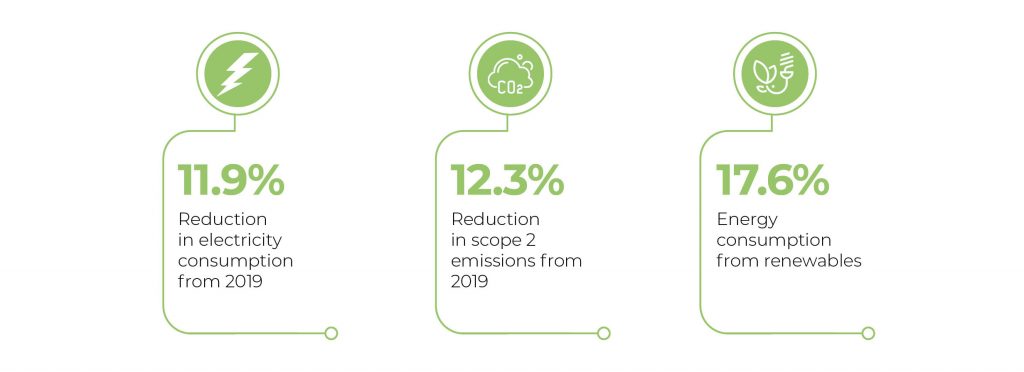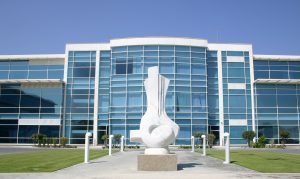Energy Management
and Greenhouse Gas
(GHG) Emissions
We recognise that globally, corporations have been amongst the largest GHG emitters. So, we are taking decisive action to monitor and reduce our GHG emissions and reducing our dependence on fossil fuel based energy is key to our low carbon transformation.

Our grid electricity dependence and consumption has reduced in 2020 owing to the 2.2 MWp solar installation at our Head Office and warehouse in UAE. This has further resulted in significant GHG emission avoidance in excess of 7,000 tCO2e. Due to the pandemic large volume of our business has moved to home deliveries resulting in increased fuel consumption in our vehicles, however, we are in process of devising a strategy to integrate Electric Vehicles into our fleet. These would primarily utilise the clean energy generated through our solar panels and therefore would also result in significant GHG emission avoidance in the coming years.

We have been estimating GHG emissions from electricity, water and paper consumption for several years, and last year we initiated the estimation of GHG emissions from our freight transport to optimise our time and reduce our carbon emissions (know more).
This year we undertook GHG mapping exercise following the Greenhouse Gas Protocol to identify hotspots of GHG emissions across our operations. Our GHG emissions hotspots were categorised into “Scopes” and are presented below.

We have also upgraded our sustainability management software and added a module on carbon footprint estimation. This has streamlined the process of carbon footprint estimation as well as provision of a better picture of our GHG performance which can be accessed remotely by multiple users and decision makers at Chalhoub.

 The environmental footprint of buildings is a cause for great concern because globally, they account for approximately 40% of GHG emissions. In response to this, all the stores that we own and operate are designed to reduce our energy and water consumption intensities.
The environmental footprint of buildings is a cause for great concern because globally, they account for approximately 40% of GHG emissions. In response to this, all the stores that we own and operate are designed to reduce our energy and water consumption intensities.
Additionally, we integrate green building principles to operate our warehouses and offices. To preserve energy and reduce emissions, we have installed energy-efficient lighting, and air conditioning units that optimise fresh air intake and have also deployed motion sensors (know more). A few buildings remain to be upgraded further which is commissioned within the next 2 years.
This year we commissioned a green building advisory firm to assess the performance of 3 of our buildings vis a vis LEED Existing Building Operation and Maintenance guidelines. The assessment highlighted the strengths as well as the gaps in sustainability performance of the buildings. The study also suggested the way forward to enhance the sustainability performance of the buildings to achieve LEED certification.
Alongside the ecommerce and operations technology that is transforming our Group, our Sustainability Management Software has been used to collect data on our sustainability performance since 2017. By doing so, we have been able to track our environmental performance regionally across several indices.
In line with our evolving sustainability strategy to strengthen our data points and ensure robust measurement systems, we have initiated the expansion of our Sustainability Management Software. The objective of this upgrade will be to calculate in real-time our Group-wide carbon footprint and Scope 1,2 and 3 carbon emissions. With this development, we can set further measurable targets to reduce our negative impact and offset the excess.

 Transport is responsible for 25% of global GHG emissions. Therefore, it’s necessary to optimise the miles travelled by our people and the products, this is central to our business model with our moral imperative as a responsible business to reduce energy consumption and GHG emissions. So, we have introduced several initiatives to reduce the impact of transportation within our network.
Transport is responsible for 25% of global GHG emissions. Therefore, it’s necessary to optimise the miles travelled by our people and the products, this is central to our business model with our moral imperative as a responsible business to reduce energy consumption and GHG emissions. So, we have introduced several initiatives to reduce the impact of transportation within our network.
Last year we rolled our FarEye, a tool to manage our last mile distribution (know more). We are in the process of enhancing its features so our delivery team can optimise the route utilising this tool.
A silverling to the pandemic is that we have sped up our Group’s plans to permanently offer remote working policy for our employees. This year, 30% – 50% of our back-office employees worked remotely which has helped in reducing GHG emissions. For example, the removal of 30% of our 2200 back office staff from the daily commute by car equates to an annual mitigation of 2,032 kg of CO2 emissions. This is equivalent to mass of carbon sequestered by 93 trees.
This year, we have also begun the exhaustive exercise of consolidating a Group-wide plan to convert our fleet to Electric Vehicles (EV). Our challenge lies mainly in sourcing suitable electric trucks which can handle the load of our trips given that EV infrastructure is in a nascent stage in this region. Meanwhile, as the study progresses, we will be installing 8 EV charging stations at our head office and warehouse in Dubai by the end of 2021.
To be resilient to climate change, we realise that we must break free from our reliance on fossil fuels and mitigate carbon emissions wherever possible. As such, we’re supporting the transformation to renewable energy that is currently underway.
In 2019, we completed the installation of 2,150kWp solar system at our Head Office 1 and Main Warehouse in the UAE, which has resulted in significant reduction of grid electricity consumption, thereby reducing corresponding GHG emission.

In 2020, we’ve installed solar panels at Head office 2 and have begun the necessary groundwork to repair the ceilings in our DIP warehouses in anticipation of completing the installation of solar panels in Q1 2021. This is expected to meet 17.53% of our building’s energy needs (based on 2019 consumption) and mitigate 200 tons of tCO2e per year. This is equivalent to 31 home’s energy used per year or o 63 tons of waste recycle per year.
In 2021 we plan to expand our rollout of solar panels to additional warehouses in UAE and KSA. This is enabling us to increasingly secure our energy from the clean sources available whilst contributing to global transformation to a low carbon planet.
